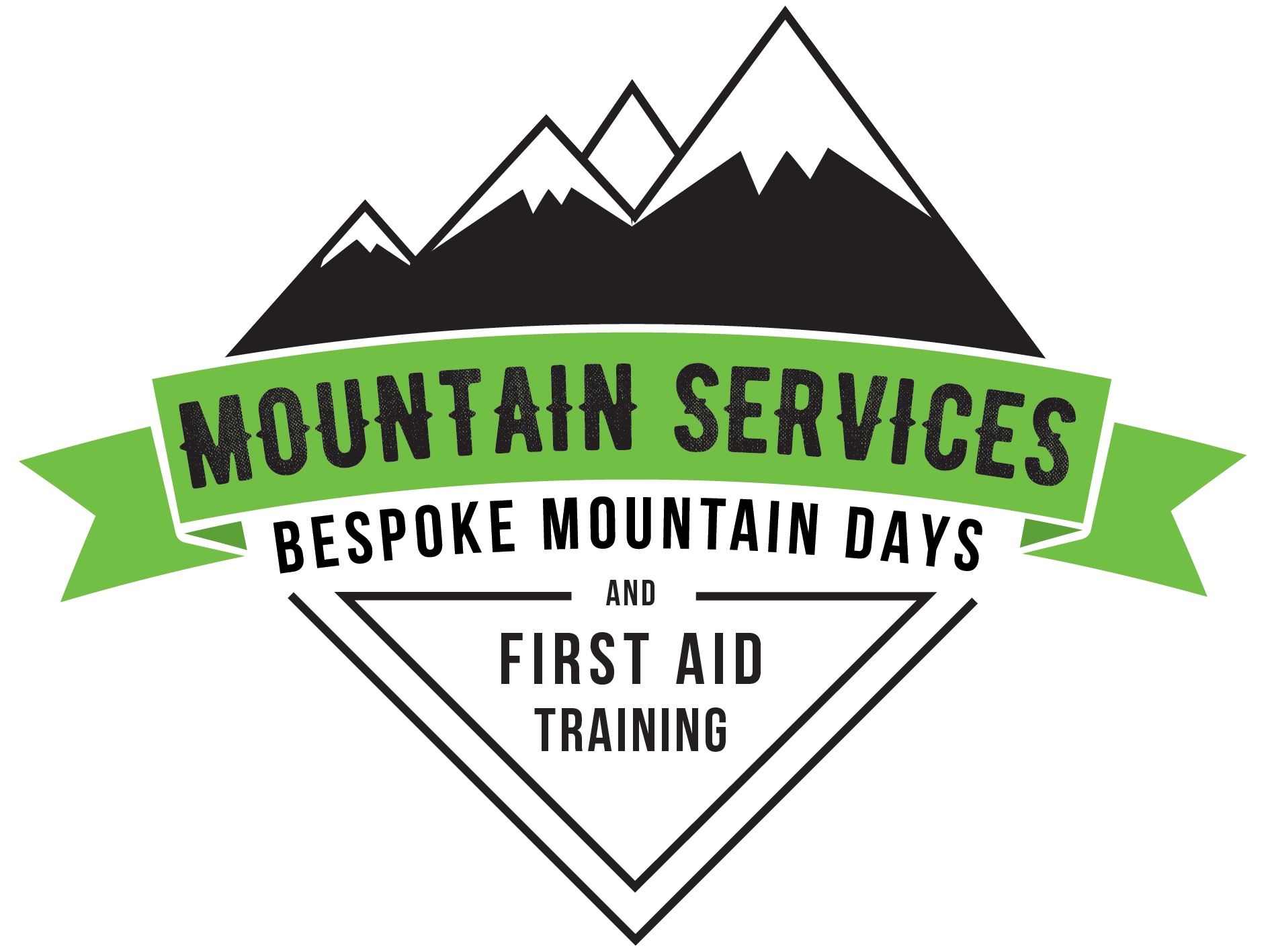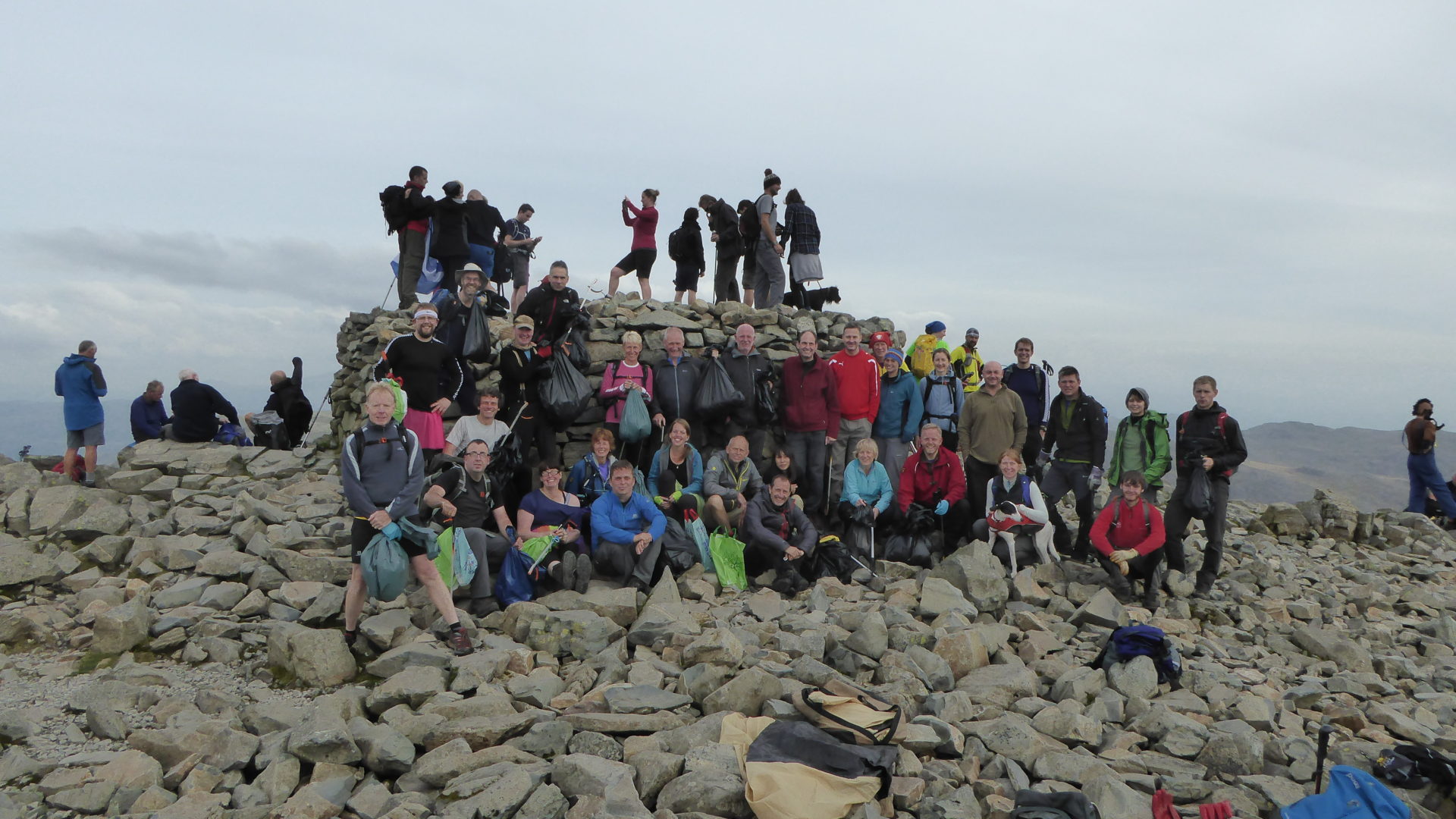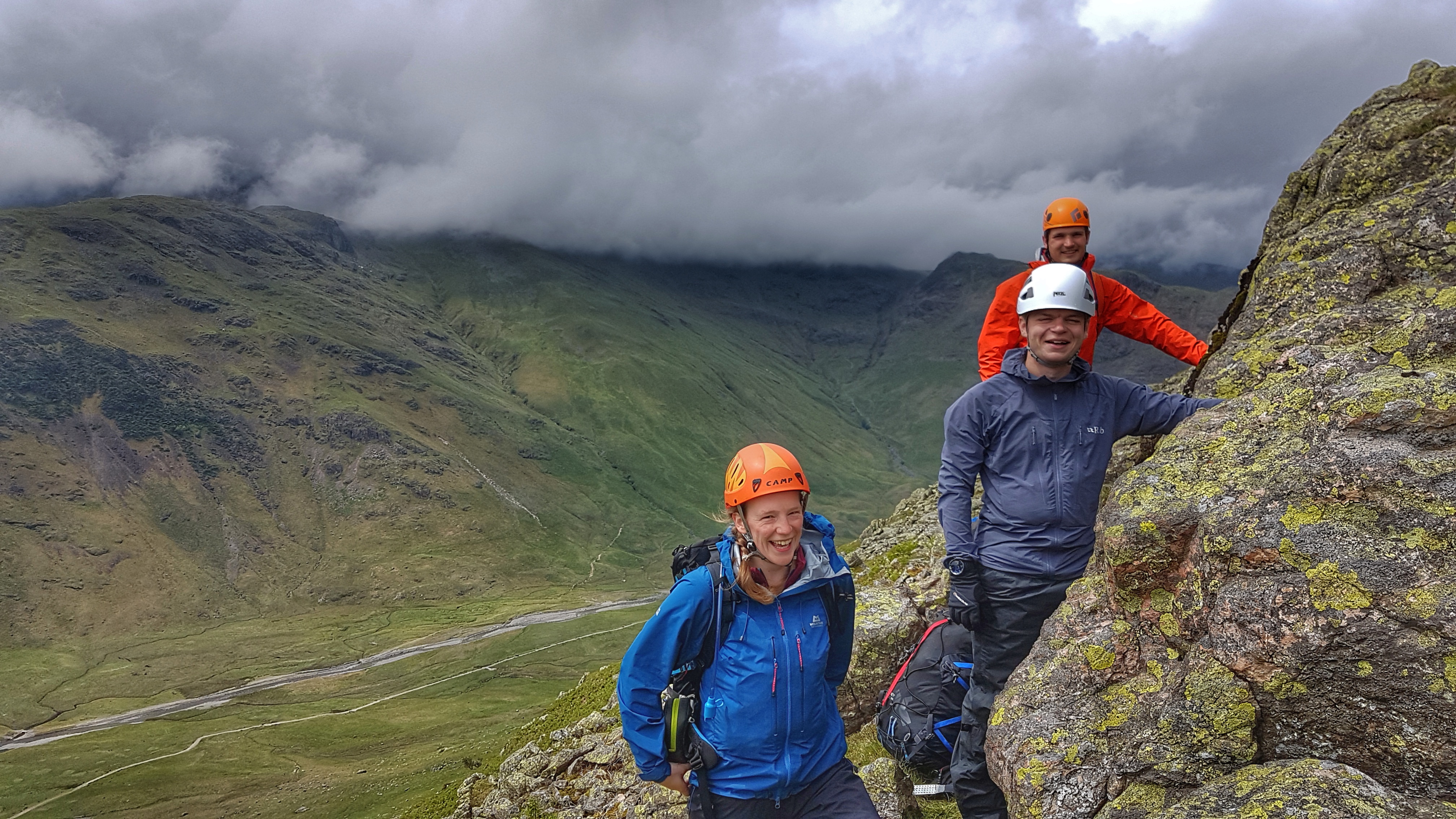The internet (well the little corner of it we mountain folk tend to visit) is awash with ‘how to pass your ML’ type blogs – so I thought I’d write one from the other side of the fence; what it’s like to make the journey to becoming an Assessor working on a Summer Mountain Leader course.
One of the strengths of the Mountain Leader course is, despite what some people might think, the diversity of how it’s delivered, the importance that’s placed on individuals developing their own skills – simply attending a training course, getting 40 quality mountain days and rocking up to assessment won’t be enough. Candidates are assessed by at least two assessors over the space of 5 days – there’s a lot going on. It also means that no two assessments can, or should, ever be the same – the mountain environment is ever changeable, add in the diversity of candidates and there are a lot of variables – so in this post I can only tell you about my experience of being an assessor and the ethos of the Course Provider / Directors I’ve worked for. Others may be different – but overall Mountain Training UKI’s quality control process should ensure you get a good experience whoever you choose.
Eight years ago, after three decades of playing in the mountains I made the decision to sell my business and start to work in the outdoors – the first step on that journey was to understand the UK qualification framework, decide “yes I do want to be qualified” and to book a course. I chose Chris Ensoll Mountain Guide for the simple reason he was the only person (of those I looked into) who made reference to courses being fun! I learnt so much on that first course – I’d a big mountain cv by that point – but I’d also gotten away with a lot by being fit and skilled – Chris made me efficient and focused. Five months later I was back for Assessment – and I learnt even more. I also got told about the International Mountain Leader Award – I booked onto it the day I passed ML.
Seven years later and it feels a bit like I’ve closed the circle. I’ve been delivering training days for Chris for a while now, this year I’ve started working on assessments.
I’ve said before and often that my own International Mountain Leader Winter Assessment was the best training course I’ve ever been on – and that’s really how I’d like all the assessments I’m a part of to be – fortunately (heck it’s not a coincidence) that’s a big part of the ethos for Chris.
Day One.
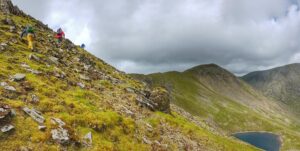
So here we are, in the fell car park under Coniston Old Man. I’ve heard often the old assessment tale of you can tell who’s going to pass by how they pick up their rucksack at the start of the day. It’s completely right…and complete tosh. We all deal with assessment nerves in different ways, but it is good to see people who are familiar with their kit (more of this later..) Whilst Chris gets seven of the candidates to gather round for introductions I have a quick search for the missing eighth. We make it back to the group just in time to catch most of the names. When it comes to me Chris smiles as I use words I first heard eight years ago. “We’re starting from the assumption that you’re all ready to pass. You’ve all read the syllabus, you’ve all been on a training course, you’ve all* got great logbooks. I believe mountaineering to be the most honest endeavour – so if you think you’re ready to pass then so do we. That’s where we’ll all start from”.
*We’re not going to highlight it even if you haven’t….but it’ll show.
Chris and I split the group basically how they’re stood next to us, honestly there’s no science or intent to it. We’ve had a genuinely brief conversation about a rough plan for the day, we know what we want from it – we just need to make sure we give you the chance to show us. By half past we’re away. Almost comically Chris turns right, I veer left. I should probably say here – Chris knows this area like the back of his hand. I know it as well as the back of a strangers hand – but, this is an Award to wander anywhere in the mountains in the UK, I like that it’s as fresh to me as the candidates. I might even look at a map today. This is the Lake District – features are everywhere, things get steep and/or wet quickly. This will be fun.
Going first on assessment can be good, it can be bad – it might not always be your choice. Here on Day One I can help with that – we go to the first few features together. We have a chat about strategies, about differences, we talk about honesty – sticking to your own plan, admitting (to yourself) it’s not working and changing tack, that sometimes we have to go back to move forwards. I’m happy to answer questions, and on the first few legs I’m happy to confirm where we are. I can see people relaxing, I can see them thinking “I can do this”, barely perceptibly navigation legs get a little further, a little harder, chatter gets slightly less.
There’s no real destination aim, there’s no tick-box list of tools I need to see. On Day one I want to settle the nerves (their’s and mine), I want the candidates to show me how they handle themselves in the mountains, I want to see them start to step up and lead, to be comfortable in the environment. I guess I’m looking to see the choices they make, that they’re thinking of the group, that they can walk and talk at the same time. It’s big picture stuff with the odd moment of focus thrown in for good measure. My group heads up the steep flanks of Brown Pike above Blind Tarn – and I can see them settling in to an understanding of what’s expected – walking to the edge to check aspect of slope, paying attention to a little series of ring contours, some clearly counting away in their heads. There are one or two questionable decisions, but we’ve plenty of time to revisit those, to put similar choices in front of one or two. But, as we cross Dow in some blustery conditions there’s also laughter, and we take a small detour to admire the view. A few local facts are also thrown in, it’s a good day out.
And let’s address that ‘local’ thing here. One of the group is exceedingly local – he can see the roof of his house for part of the day. We can’t alter that – but very very few people spend time looking for the level of feature we do on an assessment. Over confidence, that sense of knowing ‘roughly’ where you are…it’ll only get you so far. On assessment you’re going to have to focus. I know, because that very nearly caught me out eight years ago.
Day Two.

Today we’re in Langdale. The forecast is typically mixed. Everyone knows Day 2 is the steep ground day. I’ve run and worked on a lot of these by now, it’s fair to say it’s my favourite day, and it can be assessed in lots of ways. We’re going to go on a complex journey today – we won’t go far, but it will be challenging. And I’m not just looking for knot(s) skills or getting straight to the rope – what I really want to see is decision making, judgement, knowing what do do when – and doing it safely, simply and systematically.
We head out along Mickleden – the candidates have a rope per pair (turns out we actually have three – always listen to the briefing!), helmets and the rest of their hill kit that they’d normally carry for a journey in steep terrain. Somewhere beneath Gimmer Crag we wander off the track, a few hundred metres further I ask the group to relocate – this is an assessment after all. This trips a couple of them up. Whilst it’s not a navigation specific day we do expect you to know fairly accurately where you are at all times. Once this is settled I pick a prominent feature and ask one of the candidates to take us there safely. I’ve picked this knowing we’ll have to cross scree and avoid some of those pesky little bluffs that aren’t quite a contour high but do pose a risk. I’ll repeat this tactic on and off all day – I’m looking for safe route choice, personal movement skills, group management – I’m also giving the candidates a chance to demonstrate some coaching, to show me how they’ll deal with people who are unsteady on their feet (me) and that they can still walk & talk! Somewhere steep Chris is doing the same.
Eventually though we will come to an obstacle we can’t work our way around, a steepening that is perhaps a little too steep, and yes, the rope will come out of the bag. Hopefully by this time I’ve seen some spotting, some coaching, maybe even a hand for confidence or security – but as all the candidates know we will eventually need to see them handle a rope. Despite how many times it’s been written it really is the climbers who struggle most with this – because whilst I’m happy to see you use some other skills, and I’m happy to give you feedback on them – I do also need to see that you can do this without a rack of climbing toys – that you’re happy with the basics. Chris and I have had a chat this morning about the standard – I’m hoping to see candidates exceed that – and the ones who have clearly not just practised but have actually used these skills do. We do a little up and quite a lot of down – we spend as much time on confidence roping as abseiling, we talk a lot about the position of maximum effectiveness and consequences.
At the end of the day, just a few minutes after a relocation, I ask the group to take us down a gully. I can’t see the bottom. Two set off and quickly come to a halt, two stay at the top and get a map out. I can see people starting to think about choices, more about consequences, in assessment talk; dynamic assessment. I’m not trying to catch anyone out, I’m looking to see a rationale, a decision making process. After a while I ask one of the candidates who headed straight down the gully to lead us back to the valley floor. We don’t take the steep loose gully. I’ve learnt a lot, I’ve made some notes, we’ll revisit some of this for some people on the expedition.
Day Three
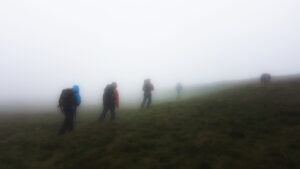
The start of the expedition. In true Lake District style summer is totally absent – it’s wet, it’s cold and cloud base is tyre height on the van. We aim to start high and set off from the Three Shire Stone – some great local folklore from one of the candidates settles us in. But, sadly, a but. It’s wet and it’s cold and one of the candidates isn’t prepared. We still have a duty of care and I can’t let them head out on exped like this. A brief chat & I lend them some equipment, it’s unusual, but I want to give them all the tools to succeed, and we will make some allowances for nerves. But it’s not great.
We’re immediately into the clag. Did I say it was wet & cold? Well that adds a layer of difficulty too. Gloves and hats are a must. Those that wear glasses, myself included, struggle a little – fortunately we also know how to cope. This really lets us test a few things – can you put a navigation strategy together? Are your basics solid? (tip – walking on a bearing will not be enough on it’s own, but when you need it it needs to be exact for the conditions you’re in). Are you keeping track of where you are – especially when it’s not your leg – or are you 100% sure you can relocate? It’s going to be difficult if you’re not ticking off, making mental notes, if you’re not aware. And now of course you’ve got expedition kit on your back, slowly, over the course of three days that will take a toll. If you’re physically tired you’re going to get mentally tired quicker too.
This is, ultimately an assessment. So the navigation points remain difficult – but I’m more than happy to see candidates re-evaluate, to tell me “I was wrong before but…” as an assessor I learn a lot more about them via that, from seeing a process, than I do from random guesses. In these conditions three of today’s group (I’m back with the candidates from Day 1) are taking their time, they’re finding confirmations at each point, even when they seem sure, they’re covering the basics. Visibility is now less than 20 metres. We’re in the rough stuff behind Crinkle Crags – it’s good to see.
But by Day 3 Chris & I have each seen every candidate, and we’ve both seen some judgement and missing understanding that we want a second look at, some of it is minor, but some, and this is rare, is fairly major. Via a series of navigation points and obstacles I’ve brought us to a place where I can take a detailed look. I make sure we’re at a point that can be located to the metre, I make sure the objective is clear. There’s no game playing – the group are being ourselves – five adults with heavy packs out in very grim conditions in a very serious place. I give the candidate as long as they need to formulate a plan and put it into place, I know however that we’re all cold and want to keep moving.
The decision when it comes is very wrong. It’s dangerously wrong. Fair enough its a plan I might have on a shorts and t-shirt day out with other experienced hill folk, but it’s not one for today. Two of the group stop and one gamely follows, but I have a duty of care – I intervene. I think all the group know it’s serious, I know it’s necessary. We find some shelter for lunch, some of the hill talks and I have a 1:1 talk with the candidate concerned.
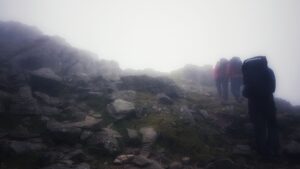
We set back off into the grim – I give the same candidate a confidence boosting leg, they nail it and smile for the first time today. The rest of the group are doing well though – I’m starting to see strategies, they’re relaxed enough to be talking about geology, the uselessness of waterproof gloves and who has what food for exped. We head well off the path, visibility deteriorates further as we descend to camp at Red Tarn. We’ve probably done less than six miles, its been an exceptionally tough day.
Chris and I have a debrief and planning session whilst the group put up their tents – most are quick and efficient – only two have arranged to share (clever teamwork) – but they’ve got the biggest best tent by splitting the weight – as one puts out the guys the other already has a brew on the go. One candidate however has a new tent, they’ve never put it up before today – turns out the poles are wrong. Collectively the group fixes it, but it’s a big bullet ducked.
It’s been horrid all day, but by early evening the cloud is lifting, blown on a strong wind and neither Chris or I can see any benefit to heading out for night navigation under the forecast clear skies and full moon. We tell the group, many head off for a sleep straight away.
Day Four
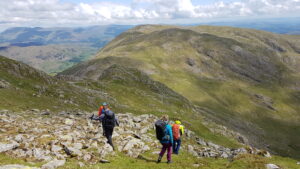
Dawns bright and clear – Bobby the dog runs around happy in the warm sun.
We’ve swapped groups again – and we have another vague plan – heading into a nice wild area with lots of potential to be lost, stuck or to simply have a grand day out. I’ve not seen these four navigate, Chris has given me some pointers but I decide we’ll play with some different maps* Heading out in general, all with the first point known, I change the plan, ask one of the candidates to take us somewhere else. Why? I’m not trying to catch people out – I want to see a relocation, an individual strategy and to see the the rest of the group are aware too. It doesn’t seem to phase anyone, but within a hundred metres one has corrected his relocation and explained why, good for me to see. Over the next couple of hours everyone leads at least a leg, they’ve all relocated and they’ve all been spot on. We mix is big broad nav and the odd tiny micro point, the aim is to show me the best Leader you can be and this group nail it. Some great environmental knowledge, some making things more exciting when asked and even some unprompted movement skills coaching as we moved onto the steep ground.
*At lunch we discuss maps – it’s become clear during the course of the morning that four candidates are using four different large scale maps – we discuss the pro’s and con’s of each, discuss why Harvey’s Mountain Map 1:40 might be different to Harvey’s Walking Map 1:40 – the group, again unprompted, swap maps for the afternoon.
As we traverse the side of the hill under Great Carrs we use the time to discuss what people want to use their award for – all four have different ambitions and hopes, all four have the potential to be exceptional leaders, as an assessor they’re proving that original assumption – they’re ready to pass. I spend a lot of the time telling them about future pathways – every so often I’ll ask for a relocation, but they have this, at one point we even take a detour to take a look at some often not seen wreckage from the Halifax Bomber that crashed here in 1944 – it’s not me who suggests it, a great way to make a day out grand.
We make it back into camp still in the sunshine, the day couldn’t be more different to the previous.
We’re camping next to rough crags – which gives Chris and I a chance to take a last look at some ropework. We have a long chat & I head left with just one candidate, Chris takes the rest in the other direction. And it’s one of those moments when you know – this is someone who hasn’t had nearly enough practice, knots, anchors and even handling the rope – non of it comes easily or correctly. After twenty long minutes missing all the obvious anchors and literally tying us both in ‘nots’, when I couldn’t in any good faith let them weight a rope, we sat down and I asked if they knew themselves if this was safe and good enough, they looked relieved and said no.
I looked across the hillside to Chris with a group displaying all the required skills and shook my head, he nodded, we’d both seen the same. I can’t speak for the candidate’s training course as I wasn’t there, but I do know they hadn’t practiced nearly enough, hadn’t been out in the hills with anyone else.
But. It takes a lot to be here and character to admit you’re not yet good enough. And that deserves recognition. I made a suggestion and it was the first time in four days I saw them smile. I had both the time and light to give them some skills to take away. We spent two hours 1:1 learning one simple knot till we could literally do it with eyes closed and behind our back. We found 6 anchors where they’d been positive there were none. And at the end of the evening, with no (physical) help from me, the candidate abseiled down a 20ft slab. Logbook or not I know that was the first time they’d done it. The look on the candidate’s face said it all, a first laugh, a brief moment of triumph , palpable relief, a result.
Tomorrow we’ll write out a detailed action plan, and even if they’re not taking home the piece of paper they wanted, they’re taking home the seeds of the skills they needs to make that happen.
Day 5
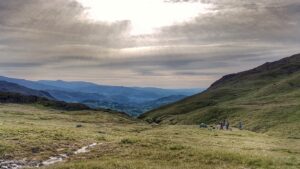
Can you guess? – Yes more navigation – but this time looking at planning – recent rain has made river crossings a real possibility. We don’t need to put you in the water on assessment – but we will take the opportunity to assess your decision making if it arrives. As assessors we pretty much know by now – but it’s a final chance to take a look at any remaining concerns, to let the candidates ask questions – to put a frame around the picture we’ve built all week.
Generally its a relaxed atmosphere in the group, there have been some very strong candidates, and on Day Five they’re showing us some skills beyond the standard – we have a demonstration of teaching navigation – some scrambling games and a couple of really exceptional hill talks.
By early afternoon we’re doing debriefings 1:1.
Just as Chris did with me a decade ago everyone leaves with a plan. Friendships have been made – some of the candidates are planning trips, some are swapping work opportunities – a couple even want to know how to register for additional awards. All have taken the candidate who didn’t pass under their wing, all have offered to hit the hills with them – the best way to get to a position where you’re really ready for assessment.
For me, as I hoped, I’ve learnt a lot. More about me, more about the journey, more about where I work, more about our very newest Mountain Leaders. Excellent.
